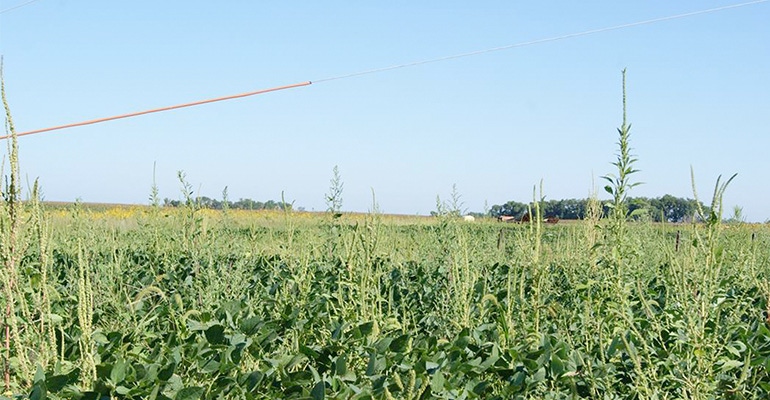
State officials last week announced the Iowa Pest Resistance Management Plan, a new effort to ensure that herbicides, insecticides, biotechnology and other tools remain effective and are easily available to farmers.
Iowa Secretary of Agriculture Bill Northey, Iowa State University College of Agriculture and Life Sciences Associate Dean John Lawrence, and Iowa farmer Larry Buss of Logan explained the plan at a press conference in Des Moines. “This Iowa-specific plan seeks to engage farmers on the issue of pest-resistance management with the goal of keeping technology and tools such as pesticides, seed treatments, and biotechnology products and native traits available and effective,” said Lawrence.
Iowa ahead of the curve
“This plan brought together a broad cross-section of Iowa ag partners to proactively address the issue of pest resistance. Pests do not recognize field borders, so it’s important we work collaboratively on this issue,” Northey said. “Iowa is again ahead of the curve in developing a state pest resistance management plan and I hope farmers take the time to learn more about the effort and consider if there are opportunities to be involved in their area.”
“The time is right for Iowa agriculture to take steps to effectively manage pest resistance and to put the best science available to use to ensure the state’s leadership in crop productivity is sustained far into the future,” said Wendy Wintersteen, dean of ISU’s College of Agriculture and Life Sciences. “The plan that’s been developed is the result of more than two years of discussions with many public and private partners, and they should be commended for their efforts.”
Goal of plan
The Iowa Pest Resistance Management Plan’s goal is to document and promote holistic and integrated management solutions that will effectively and sustainably control pests, including insects, weeds and plant disease. This includes postponing or delaying resistance development, fostering methods of early detection, and then mitigating, to the extent possible, the spread of pest resistance.
The plan includes chapters that address governance, the state of the science, pilot projects, and communication and outreach.
Projects to find new approaches
As the plan is implemented, pilot projects of active pest-resistance management will be established to encourage adoption of science-based resistance management efforts and to develop adaptive management approaches. These pilots will also seek to examine approaches to encourage successful, voluntary pest resistance management adoption.
The pilot projects will identify key stakeholders within a defined community and will be inclusive, bringing all potential players to the table. The pilot projects will work to establish incentives and novel approaches to encourage the community to work together to address the identified pest-resistant problems. These projects are intended to deal with resistance issues that are imminent or already present with the objective of minimizing the potential of further resistance development.
It is expected that the first round of pilot projects will be selected this April and get underway in May so they can be operating during the growing season this year.
A broad cross-section of the Iowa agriculture industry was involved in putting the plan together, including IDALS, ISU College of Agriculture and Life Sciences, Agribusiness Association of Iowa, Agricultural Biotechnology Stewardship Technical Committee, Iowa Corn Growers Association, the Iowa Chapter of the American Society of Farm Managers and Rural Appraisers, Iowa Farm Bureau, Iowa Independent Crop Consultants Association, Iowa Institute for Cooperatives, Iowa Soybean Association, Pesticide Resistance Action Committees, Practical Farmers of Iowa, and the Soil and Water Conservation Society.
The full plan and additional information about pest resistance management efforts can be found at protectiowacrops.org.
Palmer one proposed target
One part of the plan involves setting up a pilot project for battling the invasive Palmer amaranth, which can grow up to 7 feet tall and has been found in nearly half of Iowa’s counties. Experts advise farmers to act quickly if this weed is found in their fields.
This weed shouldn’t be ignored, as it has the potential to drive farmers out of business, says Bob Hartzler, an ISU Extension weed management specialist. “One of the problems is that one plant of Palmer amaranth produces hundreds of thousands of seeds. By just allowing a small number of these weeds to survive in a field, it could become a big problem in the foreseeable future.”
Jon Brown, an agronomy sales representative for Three Rivers FS, discovered Palmer in a field in Dubuque County in northeast Iowa. He says the cost to properly manage this weed to get rid of it could hit farmers pretty hard. “Farmers could see a spike in cost-per-acre on herbicides, if they are going to do this right. And that’s what it’s going to take.”
Palmer is difficult to control because it can grow quickly and it has resistance to many herbicides. In 2013, the weed was known to be infesting five counties in Iowa. In 2016, it was seen in nearly half of Iowa’s 99 counties.
About the Author(s)
You May Also Like




